When Walt Disney World opened the MGM-Hollywood Studios theme park in 1989, the “Magic of Disney Animation” was one of its most popular attractions. In part, this was because the theme park initially didn’t have that many attractions, thanks to contract disputes, unexpected delays and the initial plan to use part of the theme park as a working backlot, a plan which eventually proved impractical. But in part, it was because the “Magic of Disney Animation” offered a then-rare chance to see Disney animators in action in a working studio.
Of course, that meant that the animators there had to be given actual work to do.
Initially, the Florida studio—smaller than the California and Paris locations—worked on short segments of upcoming full length animated features. From a theme park and marketing perspective, this worked great. From a film production perspective, it was often a nightmare, with animators attempting to coordinate scenes from two coastlines, in the days prior to email. Eventually, studio executives agreed that this was not exactly the most efficient way of doing things. The production area was slightly expanded, and the Florida studio finally allowed to do its own full length animated features and shorts.
This meant, of course, needing to find full length animated features and shorts that the Florida studio could do. Executives compromised by sending the Florida the cheaper, lower budget full length animated features. Mulan, for example, with a budget of $90 million, went to the Florida studio, while Tarzan ($130 million), which was also a test case for developing the new, Deep Canvas animation software, stayed at the California studio.

Nearly everything that Disney planned after Mulan, however, was another high concept, prestige—read, expensive—feature, leaving executives again struggling to find work to keep animators busy and tourists entertained after Mulan. The Florida studio found itself stuck with a couple of animated shorts, some additional work on the behind schedule Tarzan, the low budget Lilo & Stitch, and, finally, an idea that had apparently been bouncing around the California studio for years—a little thing about a bear.
This later resulted in the rather uncomfortable realization that the films focused on POC characters—specifically, Mulan, Lilo & Stitch, and now Brother Bear—had been sent to the Florida studio, while the films more focused on white characters—Tarzan, Atlantis: The Lost Empire, Treasure Planet, and to a certain extent Home on the Range—stayed in California. This does not, however, seem to have been deliberate on anyone’s part: Kingdom of the Sun/The Emperor’s New Groove, set in South America, was the product of the California studio, as was Fantasia 2000, and Lilo & Stitch and Brother Bear were not, at least initially, pitched as projects focused on POC characters. With Lilo & Stitch, the initial pitch focused on the destructive little alien, and with Brother Bear, the initial pitch was just “bear.” Of no particular ethnicity.
The idea of a film based on a bear was apparently the brainchild of Michael Eisner, who liked bears. He also liked the profits from The Lion King, at that point still Disney’s hands down most successful film, as well as the profits from the little stuffed lion toys that small children happily snatched off toy racks. A bear movie, he thought, would be great follow up for this.
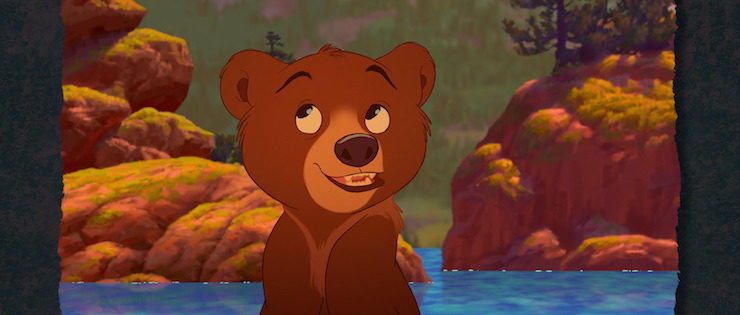
Unfortunately, Eisner apparently had no ideas for the film beyond “bear.” With no other guidance, animators and executives tossed out various ideas. Some, noting that The Lion King had been based on Hamlet (at least according to Disney marketers), thought that the bear movie could be based on King Lear or Macbeth. Or possibly a Greek tragedy, like Antigone. Other animators suggested following the example of Bambi and just focusing on, well, bears.
A third group had some thought about doing a second film focused on Native Americans. This time, to avoid further controversy, the studio would also avoid any pretense of historical accuracy whatsoever, and instead present something loosely—very loosely—based on Native American culture. Others thought Alaska was a very pretty state that could inspire some lovely background art. Disney executives felt—very strongly—that the film should center on boys. Disney marketers wanted the film to bring back Phil Collins to replicate his success with Tarzan.
The final concept more or less mingles all of this: bears, something that is vaguely meant to be Inuit culture except set 10,000 years ago to handwave any cultural inaccuracies as “well, things change,” hints of tragedy and destiny, some cute bunnies, a very male cast, lots of bland Phil Collins songs, plus two comedians voicing Canadian moose.

About the moose. Look, I like Rick Moranis and Dave Thomas, as far as that goes, and they can be funny, but their HI WE ARE VERY OBVIOUS CANADIAN MOOSE WHO SAY EH gets, how can I put this, tedious very quickly, even when they get stuck on mammoths, and even knowing that they are resurrecting their characters from their old SCTV show.
Anyway. The moose are, fortunately enough, a pretty minor part of the film, which mostly focuses on the story of three brothers, wise leader type Sitka, middle brother Denali, and young brother Kenai, who just can’t wait to be big and have his manhood ceremony and all that, and if you are having problems distinguishing them, no worries, since just a few minutes in, one of them is dead and another one is a bear, making it much easier to tell them apart.
This happens largely because Kenai is the sort of thoughtless teenager who, despite being told about twenty times to tie up the fish so that it’s safe from bears, does not, in fact, tie up the fish so that it’s safe from bears. Kenai chases after the bear, leading to an encounter that leaves Sitka dead. A furious Kenai kills the bear. Led by the now dead Sitka, the spirits transform Kenai into a bear in retribution. This also transforms Brother Bear’s aspect ratio and color palette: as Kenai awakes in bear form, the film stretches, filling the screen, and the colors brighten, as if to show us just how much we humans miss by not being bears.
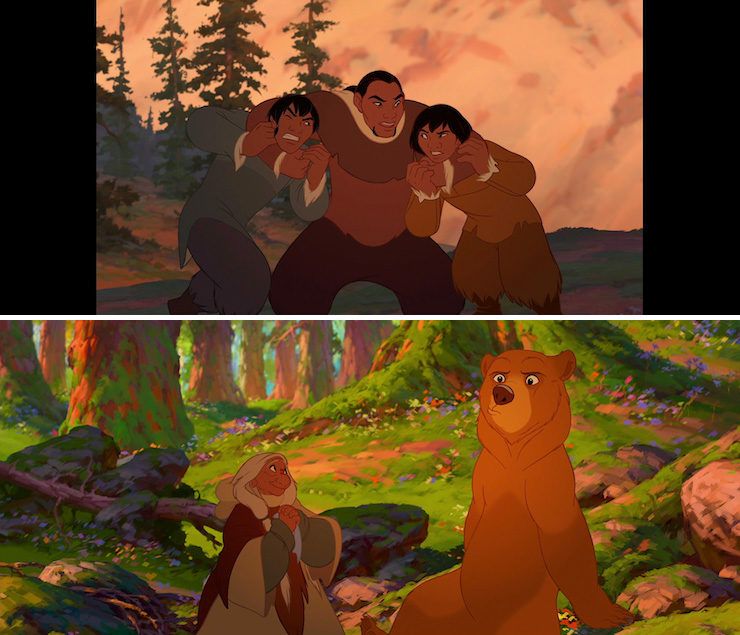
I’m sorry to say that Kenai is not overly impressed by the brightened color palette and wider view, but only wants to be an angsty human again. That, the tribe’s wise woman informs him, can only be done by the spirits, which apparently requires traveling for days and days and days to the mountain where the lights hit the earth, even though the spirits were RIGHT THERE transforming things just a few hours previously, so why, exactly, they can now only be reached on this one mountain is not at all clear.
Also not at all clear: why Denali, who just a few scenes previously was correctly refusing to blame the bear for his brother’s death, now decides he has to hunt bear-Kenai in revenge for the deaths of both his brothers. Yes, the film does throw in a brief scene of Denali remembering Kenai arguing that the bear partly responsible for Sitka’s death needed to be killed, and that a real man would go after the bear—but the film also threw in several scenes showing that Denali doesn’t think much of Kenai’s judgment or advice, and going after that bear seemingly led to Kenai’s death, so it’s unclear why Denali’s response to all of this is to pick up a spear and go after the bear again. Even if the bear did, apparently, kill both of his brothers, and even if he’s weighed down by guilt.
Quite clear: just why Koda, the small bear cub who insists on traveling with Kenai to the mountain and the lights and the salmon run, has been abandoned by his mother. That is, clear to pretty much everyone not named Kenai. (The movie’s attempt to present this reveal as a surprise mostly reveals, yet again, that Kenai is not exactly the most observant human or bear.) Since Kenai is more than a bit of a dolt, he lets Koda guide him to the salmon run and the mountain with the lights, somewhat protecting the smaller bear while learning something along the way.
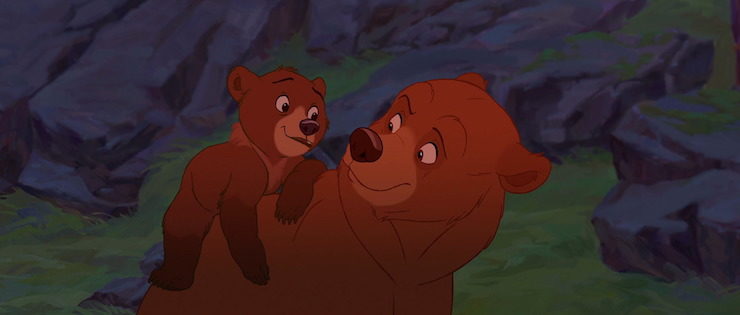
This is meant to be the cheerful, bonding part of the film—with the exception of a brief chase over a volcano which should get more characters killed than it does—and yet, it turns into the completely predictable, much more boring part of the film. It’s colorful, and the bears are cute, but it’s also soporific. To keep myself awake, I started asking questions.
For instance: if this tale is, indeed, set in a time when mammoths still walked North America, then why is every other mammal on screen a distinctly modern species from the 20th/21st century? I guess we can argue that bears and rabbits and salmon haven’t changed that much, but what are modern moose doing there? Since Kenai still has fairly good control over his paws, why doesn’t he draw some sort of picture message for Denali? Why doesn’t Tanana let Denali know what’s happened? Given that when Denali finally catches up with Kenai for the third time, Kenai happens to be near a number of other bears, why is Denali so sure that he has the right bear. Is Denali just a serial killer?
That’s just the practical questions. On the ethical side, well—the film really really really wants us to believe that hunting is evil and everyone should get along with bears and certainly not hurt them, going right to the point of calling human hunters monsters. It’s a typical Disney message, of course, and one I generally applaud, but one that’s slightly lost by showing us bears happily hunting and eating fish, and one that ignores that the original human/bear confrontation in the film started off not because hunting is evil, but because of human carelessness—Kenai not tying up the fish properly—and, technically, theft—with the bear stealing Kenai’s fish. In other words, no one in the film started out intending to attack or hunt bears, and I can’t help but think that both the bears and the humans are going to go right back to hunting once the cameras are gone.
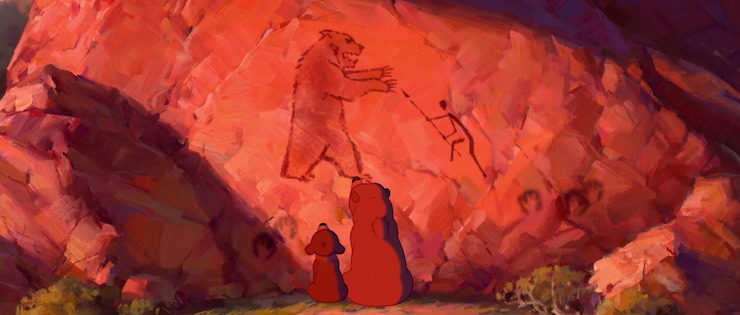
Brother Bear does do a few things well: the lights on the glacier and in the sky are glorious. Many of the bear scenes are adorable. The trick with the aspect ratio, if somewhat lost on the Netflix transfer (watch this on Blu-Ray), works decently enough as a storytelling device, and I like the way that, as a bear, Kenai’s vision isn’t just widened, but brightened: the entire color palette changes, only to dim again when Denahi is in view.
And I have to admit, I kind of like the end, where Kenai decides to remain a bear. Sure, it’s telegraphed, and sure, even with the telegraphing, it doesn’t really make all that much sense: surely, the entire point of all of this in the first place was to turn Kenai into a better human, not a better bear. And I’m not really sure that I entirely buy Kenai’s argument that “Koda needs me.” Little Koda certainly needs a family, but I’m not really sure that Kenai needs to stay a bear to be that family. After all, Koda and Kenai do share a (brief) moment as cub and human as well, and seem to do just fine. More to the point, Kenai—as the film frequently points out—is not very good at being a bear. He has no idea how to get himself out of traps—or how to avoid them. He has no idea how to hunt for salmon, a kinda critical part of the bear feeding process. He knows nothing about bear society. Koda spends quite a bit of time taking care of him.
But anyone who realizes that a life of playing in water with bears sounds a lot more fun than a life with angsty humans gets my vote. Especially when said humans—and their spirits—get all angsty just because you forgot to be responsible for one moment in a day meant to be a big party for you, and half of said humans mock a totem dedicated to the importance of love. You go, laid back, playful bears. You go.
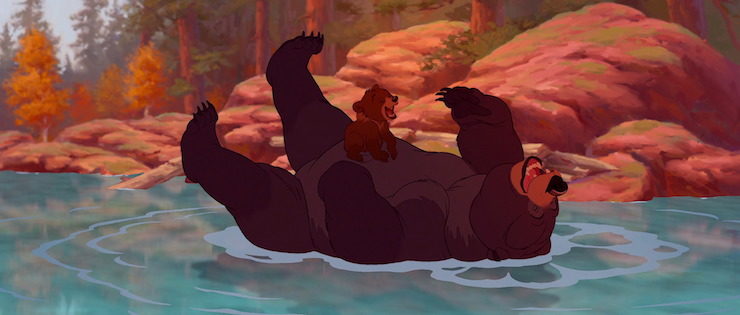
Brother Bear might have had the time to fix its flaws in storytelling and humor, but instead, the film found itself suddenly rushed to production when the California studio realized that its next production, Home on the Range, was not going to be ready in time to meet its 2003 release date, leaving Disney without a 2003 release. To avoid that issue, portions of Brother Bear were hastily shipped off to the Paris studio to be finished up, allowing the film to be released in November 2003—coincidentally (at least according to some Disney sources) just as the platinum edition DVD of The Lion King hit stores in time for Christmas.
The comparison did Brother Bear very little favors, especially since even with the aspect ratio and coloration stunts and the lovely light effects, nothing in Brother Bear came even close to The Lion King’s opening and wildebeest stunt sequences. Rather than showcasing another triumph in Disney animation, the result seemed instead to showcase just how much Disney had declined since the peak of the Disney Renaissance.
Perhaps partly as a result of this, Brother Bear received mixed reviews, though it did decently enough at the box office, bringing in $250.4 million—one of the few Disney animated films between the Disney Renaissance and the later John Lasseter period to earn any sort of profit at all, if just slightly overshadowed by another little film released that same year, Finding Nemo, which brought in $940.3 million (and counting.)

Disney released the now-standard merchandise of clothing, trading pins, and plush toys—notably bears. The film is still widely available on DVD, Blu-Ray and various streaming services. Brother Bear also spawned the now seemingly mandatory sequel, Brother Bear 2, featuring a bear and a human girl slowly falling in love—I’d say you have to watch the video to get it, except that I would not be performing my duty if I urged anyone to watch that video.
And yet, slowly, the film fell into obscurity. A little more than a decade later, although unrelated toy bears and Finding Nemo merchandise can be found pretty much everywhere throughout the theme parks, the Brother Bear merchandise had mostly vanished, except with the ubiquitous trading pins.
The Florida studio had already closed its doors. With animated film after animated film flopping, Disney executives decided that the experiment of running separate animation studios in California, Florida and Paris had run its course, closing both the Florida and Paris studios shortly after the release of Brother Bear. A painful closure, especially since all three of the full length animated films mostly produced in Florida—Mulan, Lilo & Stitch, and Brother Bear—had been hits.
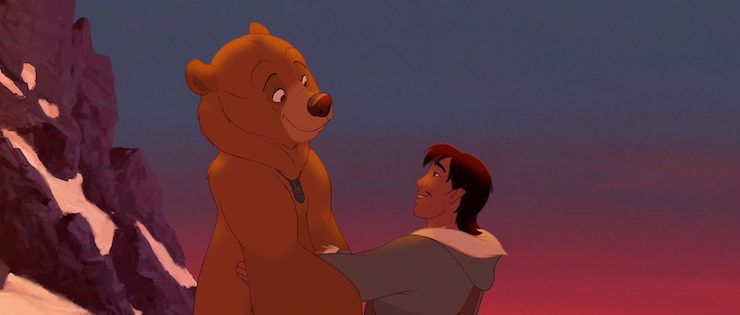
Indeed, of the three films that pulled a profit during the ten year doldrums between the end of the Disney Renaissance (the 1999 Tarzan) and the beginning of the John Lasseter era (the 2009 The Princess and the Frog), exactly none were made at the California studio. Dinosaur, the third financial success, was produced in California, but not at the Disney Animation Studios.
And yet, the Florida and Paris studios were the ones to close. The “Magic of Disney Animation” was turned into a character meet and greet area, with some interactive games, a room where an artist would run tourists through the steps of creating very simple Disney characters (I drew Chip AND Mickey AND Donald), and the ubiquitous store selling Disney fine art. In July 2015, this, too, closed, to be replaced by the Star Wars Launch Bay, putting Star Wars props and character meet and greets in the rooms where Disney animators had once worked.
But if Brother Bear marked the end of the Florida animation studio, it was not quite the end of Disney’s hand drawn animated films. One more major financial disaster was needed before Disney began its nearly complete retreat from the art form it had mastered in the 1930s and produced steadily every decade since.
Home on the Range, coming up next.
Mari Ness lives in central Florida.










